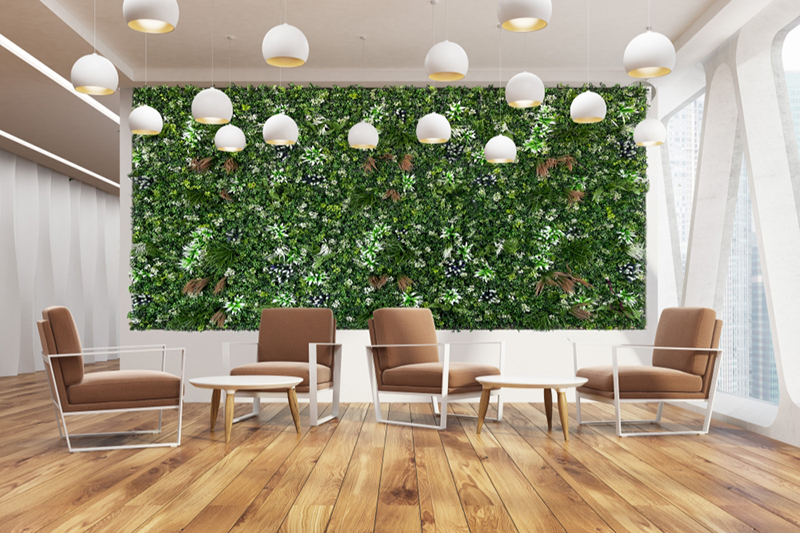Social Benefits Assessment of 3D Artificial Vertical Gardens
The integration of 3D artificial vertical gardens into urban environments is transforming how communities interact with green spaces, offering solutions to social challenges tied to mental health, social cohesion, and environmental equity. By analyzing their impact on public well-being, accessibility, and cultural engagement, stakeholders can recognize the broader societal value of these installations beyond their aesthetic appeal.

Improving Mental Health and Well-Being Through Biophilic Interaction
Urbanization has led to a disconnect between people and nature, contributing to rising rates of stress, anxiety, and depression. 3D artificial vertical gardens address this gap by bringing greenery into densely populated areas where traditional parks are scarce. Research indicates that exposure to natural elements, even in artificial forms, reduces cortisol levels—a hormone linked to stress—and improves cognitive function. For instance, office workers with views of green walls report higher job satisfaction and lower absenteeism compared to those in sterile environments.
In healthcare settings, vertical gardens play a therapeutic role. Hospitals incorporating green walls in waiting areas or patient rooms observe faster recovery rates and reduced reliance on pain medication. Similarly, schools with vertical gardens on facades or courtyards create calming atmospheres that enhance student focus and reduce behavioral issues. These benefits are particularly critical in low-income neighborhoods, where access to private outdoor spaces is limited, and public green areas are often overcrowded or underfunded.
The sensory engagement offered by vertical gardens further supports mental health. Textured leaves, fragrant herbs, and visually dynamic plant arrangements stimulate multiple senses, fostering mindfulness and relaxation. Some designs even incorporate interactive elements, such as touch-sensitive vines or sound-dampening moss panels, encouraging users to engage with nature in meaningful ways.
Fostering Social Cohesion in Diverse Communities
3D artificial vertical gardens act as communal hubs, bridging demographic divides and encouraging social interaction. In residential complexes, shared green walls on building facades or rooftops become gathering spots for residents, promoting neighborly connections. Community-led projects, where locals participate in designing or maintaining vertical gardens, strengthen collective identity and pride. For example, a neighborhood in Barcelona transformed a drab parking garage into a vertical garden through collaborative workshops, sparking ongoing dialogue among residents of different ages and backgrounds.
Public installations in transit stations, bridges, or underpasses also serve as inclusive spaces. By replacing graffiti-covered walls or neglected areas with vibrant greenery, these gardens create safe, inviting environments for commuters and passersby. In cities with high immigrant populations, vertical gardens can incorporate culturally significant plants, celebrating diversity and fostering cross-cultural understanding.
Moreover, vertical gardens mitigate the effects of urban noise pollution, a common source of tension in densely populated areas. Plants absorb sound waves, reducing noise levels by up to 10 decibels in some cases. This acoustic benefit makes public spaces more enjoyable, encouraging people to spend time outdoors and engage with one another.
Enhancing Environmental Equity and Accessibility
Access to nature is often unevenly distributed, with marginalized communities facing the greatest barriers. 3D artificial vertical gardens help level this playing field by introducing greenery into underserved neighborhoods without requiring large land parcels. For example, a vertical garden installed on a housing project’s exterior wall provides residents with daily contact with nature, regardless of their apartment’s orientation or floor level.
These installations also improve air quality in pollution-heavy areas. Plants filter particulate matter and absorb gases like nitrogen dioxide, which are linked to respiratory illnesses. By strategically placing vertical gardens near schools, hospitals, or senior centers, cities can protect vulnerable populations from environmental hazards. A study in London found that green walls near busy roads reduced airborne pollutants by up to 40%, offering measurable health benefits to nearby residents.
Accessibility is another key advantage. Unlike traditional gardens that may require physical ability to navigate uneven terrain, vertical gardens are designed for inclusivity. Raised planters or modular panels allow people with mobility challenges to participate in planting or maintenance activities. Some designs even incorporate braille labels or audio guides for visually impaired users, ensuring that green spaces are truly universal.
Empowering Education and Workforce Development
3D artificial vertical gardens serve as living laboratories for STEM education, teaching students about biology, engineering, and sustainability. Schools with vertical gardens on campus use them to demonstrate concepts like photosynthesis, water cycles, and renewable energy. Hands-on projects, such as designing irrigation systems or monitoring plant growth, develop critical thinking and problem-solving skills.
The industry also creates opportunities for workforce development, particularly in urban areas with high unemployment rates. Training programs in horticulture, 3D design, and smart technology equip workers with skills relevant to the growing green economy. For example, a vocational school in Detroit partnered with local architects to offer courses in vertical garden installation, helping residents transition into well-paying jobs in sustainable construction.
Conclusion: A Catalyst for Inclusive Urban Transformation
The social benefits of 3D artificial vertical gardens extend far beyond their visual appeal, addressing systemic issues like mental health disparities, social fragmentation, and environmental injustice. By integrating these installations into urban planning, cities can create more equitable, resilient, and vibrant communities. As the demand for sustainable infrastructure grows, vertical gardens emerge as a powerful tool for fostering human connection and improving quality of life in an increasingly urbanized world.
Contact: Amy
Phone: 86-15311787313
E-mail: info@foszmac.com
Whatsapp:86-15311787313
Add: Fengtai District, Dacheng Road, No.24 Building, Room 203, Beijing, China